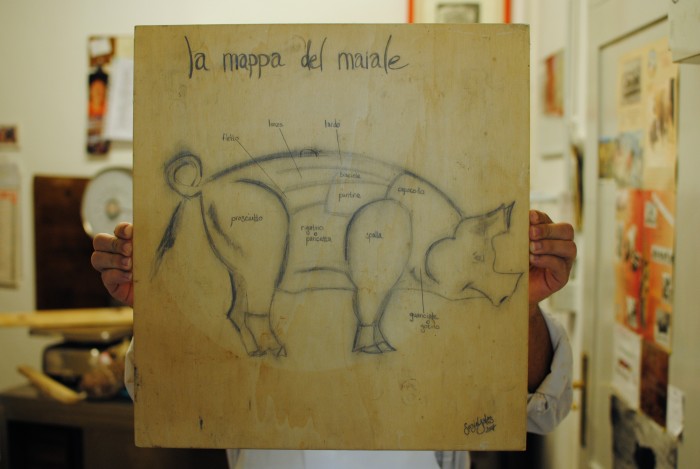
I have always had a complicated relationship with pork.
Growing up in an observant Jewish community, I looked down on pork as the unappetizing lunch meat of gentiles. Like many modern American Jewish families, we bent the rules of kashrut to suit our lifestyle, but pork was never — literally or figuratively — on the table.
My freshman year of college was the first time I lived and ate outside of a tight-knit community of other Jews. I was beginning to question my adherence to the dietary laws of not mixing meat and milk, no shellfish and no pork. Without a community or a home kitchen to maintain the practice, keeping kosher seemed more and more like an untenable expression of my Judaism, a disjointed set of rules that hindered my budding interest in EATING EVERYTHING.
Bacon seemed like an approachable place to start. My first summer home from college, I worked as a waitress at Geraldine’s Counter in Columbia City, where the bacon was thick-cut and plentiful on weekend mornings (it still is). One summer afternoon after my shift, my Ismaili Muslim friend and fellow pork neophyte joined me in sin: three strips of applewood-smoked bacon laid out unceremoniously on yellow Fiestaware.
I remember that the bacon was tasty, if a little overpowering. I ate it in tiny pieces. But it was a defiant symbol of my own personal culinary emancipation, and began the start of a journey to understand and enjoy pork.
Once I accepted my place as a lapsed Jew, I entered the next battleground of pig products: food ethics. I was in my early 20s, swept up in the national concern around industrial food production, climate change, and sustainable agriculture, where the villain was often a PETA-branded image of a factory farm. With films in my rearview like “Super Size Me,” “Food Inc.,” and that ‘This American Life’ episode where the cameraman pukes while filming onsite at a pig farm, I remained skeptical of pork and its merits.
Then I went to Italy.
Just a few weeks ago, my sister Molly and I sat side by side in an outdoor terrace in a tiny slice of bucolic Tuscan paradise, face to face with a plate of cured meat. Molly, a plant-eater for most of her adult life, came to Spannocchia’s organic farm and education center as an intern to address unanswered questions about how she should eat, and I jumped at the chance to join her.
On our second day together, Jessica Haden, an American ex-pat with a Master’s degree in Italian Gastronomy, gave a talk on the farm’s salumi operation. Spannocchia is known for its heritage breed of pigs that are the source of more than 20 different organic products eaten by the farm’s guests from around the world, and sold in the nearby town.
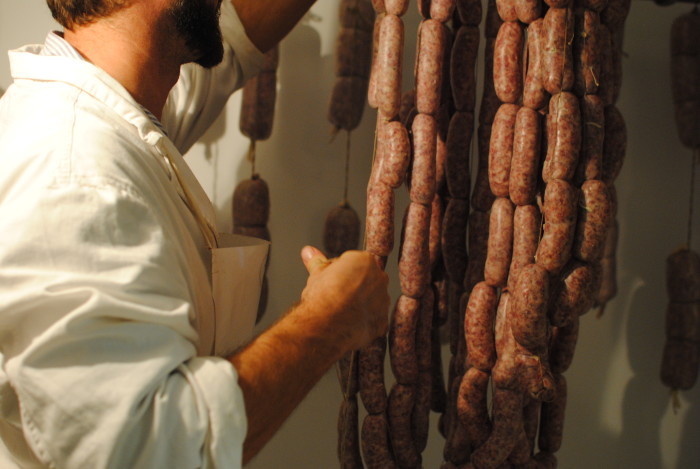
Haden encouraged us to reach for the first product for sampling: lardo. I watched Molly dangle the white strip of pork fat in front of her nose, examining it like a surgeon.
I reached for the basket of bread, and then I was stopped.
“No no, the bread is just a palate cleanser,” Haden said, insisting that tasting lardo ought to be an organoleptic experience — enacting all of the senses. “You want to really taste it, smell it.”
That meant I was to put the entire slippery thing in my mouth with my hands and chew.
The lardo was one of the most memorable food experiences of my life. The fat melted onto my tongue while I took in hints of walnuts, butter, black pepper, and rosemary. I imagined trying to eat a spoonful of butter or olive oil and shuddered — and yet somehow, this was a legitimate food! I rejoiced. We tried others in the same way, from the spicy coppa with the muscle running down the middle, to the wild fennel-seed encrusted capocolla, to the more traditional salame da vino, made by fermenting the meat with red wine. With each taste, we slowly took in the experience of each flavor, while learning where in the pig’s body it came from and by which method it was preserved: salt curing, air drying, fermenting, or boiling.

Each method, Haden explained, takes extreme precision, time, an understanding of science and an appreciation for an ancient method of storing and preserving some of the most calorically valuable foods that kept the Etruscans alive pre-refrigeration. Tuscan peasants left no stone unturned in the art curing of meat; using blood in the buristo, boiled pork rinds in chicoli, and pieces of meat picked off the skeleton in sopressata. Rather than avoid discussion of the fact that our lunch was once living, the pigs in salumi form were honored and celebrated.
If there is truly such thing as “happy pigs,” they live at Spannocchia. The 150 or so Cinta Senese roam freely through acres of wildlife preserve, surrounded by fences that keep the cinghiale, or wild boar, from entering the vineyards and gardens at night. The pigs at Spannocchia live a decadent life that consists of foraging chestnuts and acorns from the property, being fed organic farro, milled flour, black beans, and barley and rolling in the mud. These are the ‘one percent’ of swine.
The Cinta Senese pigs—named for the distinctive white cinta, or belt, across their bellies—nearly went extinct in the 1980s, but farms in the region (including Spannocchia) joined a government program to help repopulate them. After all, the pigs historically could be found only in this specific region of Tuscany, and were known for making a superior product.
“You can absolutely tell the difference,” said Haden. She spoke of the flavor of Cinta Senese, as a sommelier talks about the “terroir” of a glass of wine. “You can taste and feel a difference in the fat—after all, you are what you eat.”
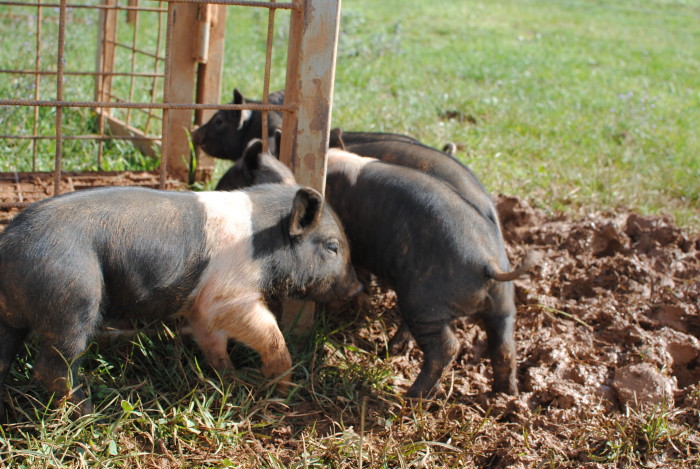
But products like Spannocchia’s salumi are a rarity, even in purist food cultures like Italy’s. Italy followed America’s path post-WWII with the industrialization of the meat industry, and you can find many processed meats made from antibiotic-fed animals in large grocery stores throughout the country.
Still, there are many ways that Italy does pork better than the United States, and I took note of a few.
It helps that romance languages make a cardboard box sound like the subject of a Shakespearean sonnet. There’s a reason why an American might pay more for guanciale than “pork jowls” at a grocery store, or why I’d prefer to order sopressata over “boiled head cheese” at a restaurant.
But even more than language, Italian food culture is entrenched in a sense of place. Part of what is so disturbing about the American meat industry as described by Upton Sinclair is the disconnection from what is eaten and where it comes from.
But Italian food is inseparable from its geographic origins, often literally. Bologna, a sausage made from mortadella that has origins in the city with the same name, bears no resemblance to the American-ized “baloney” that is synonymous with “a load of crap.” Even the name of the Cinta Senese pigs refer to Siena, its region of origin. And although Spannocchia is less than two hours from the Mediterranean Sea, you won’t find any seafood in Tuscany. Instead, pigs reign; along with wild fennel, porcini mushrooms, wine, pecorino, and whatever else grows near.
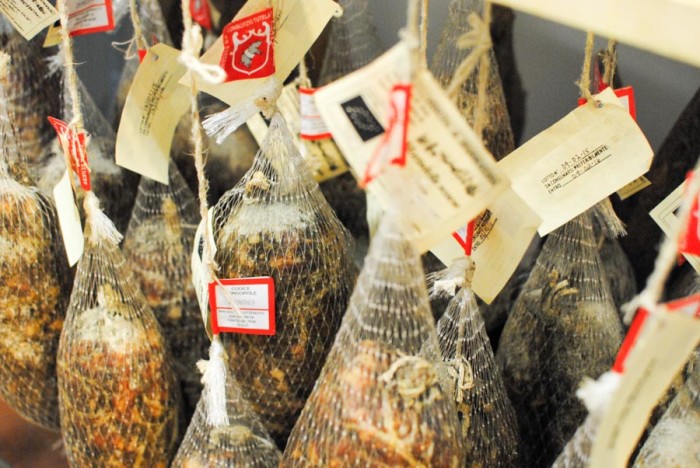
Finally, and perhaps most importantly, Italians aren’t afraid of fat.
“In the States, there was this obesity epidemic, and people needed something to blame,” said Haden, who has been living in Italy since 2010.
“So why wouldn’t they blame fat? It became this villain.”
But Italy has always had a culture of celebrating fats, especially olive oil, which is widely known for its health benefits and used liberally in Italian kitchens. “In Italy, a 10-year-old knows how to pull the casing off of salame. It’s like us eating peanut butter and jelly sandwiches.”
Good salumi itself is, in many ways, a more ethical product than the steaks and drumsticks that we associate with American meat eating. The economically-minded peasants who founded the cuisine of Tuscany abhorred waste as a matter of survival, and curing was a way to use every piece of the animal. And while most pork products rely on the tenderest meat from the youngest pigs, the curing process is forgiving, utilizing pigs that have lived full lives.
Luckily, Seattle is home to a thriving Italian restaurant scene, including the beloved restaurant Salumi, a tiny hallway in Pioneer Square that would be easy to miss if not for the line that begins forming as early as 10:30 a.m., and the crowds seen streaming out all afternoon, carrying enormous sandwiches and to-go meatball containers.
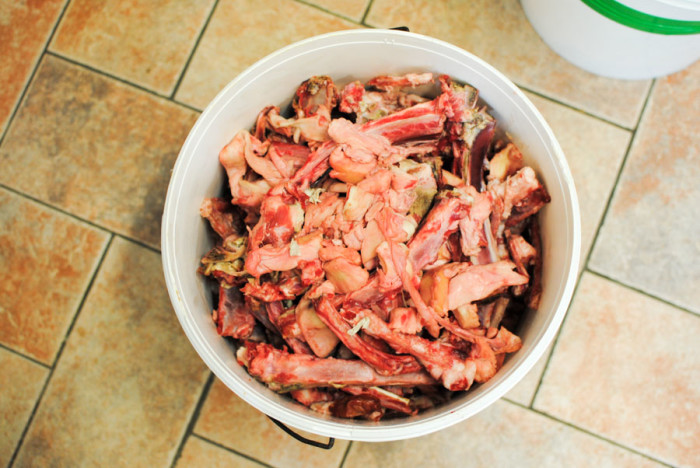
Given the purist tradition of salumi-making and commitment to regional specialty, I wondered whether our local outpost would offer different varieties from those I tasted in Tuscany. Bryan David, the chef at Salumi, said fans were “almost rabid” for the lamb proscuitto and the mole salame, made with cinnamon, chocolate, and chiles. They also make weekly and seasonal specialty items, continuing to invent new products using old-world methods.
“I don’t know anyone else that does what Salumi does,” David told me. “We don’t have the option of doing something else, so we don’t make compromises.” Armandino Batali (father of Mario), a descendant of the Seattle food supplier giant Merlino Foods, opened Salumi in 1999 in an attempt to preserve the Tuscan food traditions of his family. Later, he took on the project of incorporating American heritage breed pigs into Salumi products, similar to the Cinta Senese in Italy. It was a challenge to find pigs that were both family farmed, and large enough to meet the fat-to-lean requirements of many of his inherited recipes.
“In this business, fat is our friend,” writes Armandino on the Salumi website.
Making and finding pork products with the highest standards of quality, taste, and ethical production is not easy. And like the peasants who invented the original salumi, we should reserve meat eating for special occasions, lessening our impact on the environment and, as we heard last week, our risk of cancer. But in moderation, there’s no reason we can’t enjoy pork made from ‘happy pigs’ like the ones at Spannocchia. And yes, fat too.
Want to try delicious Tuscan-style cured meat here in Seattle? Salumi is open for lunch Monday through Friday. Get in line early, and catch Armandino’s wife Marilyn making fresh gnocchi in the window on (most) Tuesdays. 309 3rd Ave S @SalumiSeattle


As an Indian brought up with Hindu dietary traditions (and nothing else from the religion), I completely identify with the freedom of tasting pork :) I’m an occasional meat eater and yes, it’s not quite as easy to ascertain the food source here. I’ll have to try out Salumi!
Unfortunately what you experienced is not common at all in Italy. It has quite possibly the worst record for animal welfare in all of the EU and beyond. My family is from Italy and the change from when I was a child to now (about 40 years of experience) is mind boggling. Look at the percentage of animals with zero grazing. Over 98% are confined with never experiencing the outdoors. I’ve just driven through the Po Valley (Parma) and it made me cry. I cannot in good conscience eat the meat products in Italy any longer.
Loved this- available anywhere but Seattle in the US?